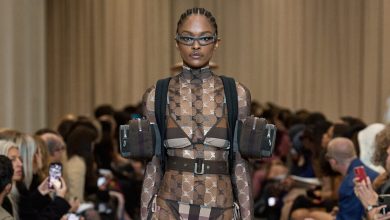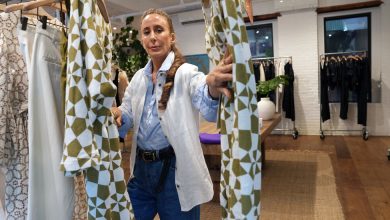When a Track Suit Embodies a Nation

The dystopic, fantastical show “Squid Game” — a bloody, nine-episode thriller by South Korean director-writer Hwang Dong-hyuk that has been lauded for its searing critique of capitalist society — continues to be a worldwide sensation. Approximately 142 million people have streamed the series since its debut in September, according to Netflix, and its elaborate Chekhovian guns have set off fan theories about every imaginable element.
But it is worth taking another look at the numbered green tracksuits worn by the show’s main characters, for they offer a specific, symbolic window into Korean culture. Despite the global appeal of “Squid Game,” the ubiquitous, normcore outfits function as a commentary on the nation’s social classes, politics and history.
“The show is really talking about Korean society,” said Jae Won Chung, a literary translator and Korean studies professor at Rutgers University, in an interview. And when it comes to the tracksuits, “there are so many levels to it.”
Tracksuits have become a mark of social status in contemporary Korean culture, said Jooyoung Shin, a fashion design professor at Indiana University.
“When I saw the green tracksuits, the first thing that came to mind was this notion of ‘baeksu,’” Ms. Shin said, using common slang for someone who is out of work. “Baeksu,” which translates to “white hands,” suggests that idle days make for shamefully clean palms.
In K-dramas, seeing someone head to the corner store during the workday, dressed in training-bok — as tracksuits are called — has become visual shorthand for “characters who are branded as losers, who haven’t gained financial independence from their parents or family or are somehow neglected by the dominant social group or discriminated against in society because of their failures,” Ms. Shin said. “Training-bok has become a symbol of this life of baeksu, having this very idle, even parasitic, life.”
Ms. Shin’s reading is evocative of another runaway South Korean hit: Bong Joon Ho’s 2019 Oscar-winning film, “Parasite.” In an early scene, the son, Ki-woo, catches up with an old high school pal over drinks and refers to himself as a baeksu — the prospect of college stunted by his family’s hapless finances.
The coded stigma tied to dress is a dead ringer for the pool of 456 contestants in “Squid Game,” who are united in their desperation for a Hail Mary escape from their financial debts. Though most of the show’s contestants are middle-aged, it’s not out of the question that player 001 — an elderly man whose true sinister involvement in the games is revealed by season’s end — is in it to win it.
South Korea’s elderly poverty rate is among the highest in the Organization for Economic Cooperation and Development member nations, according to the O.E.C.D.’s most recent data, despite the fact that the country has risen from postwar poverty to become one of the world’s most prosperous economies in a mere half-century.
Kyunghee Pyun, an art history professor at the Fashion Institute of Technology, found an undeniable likeness in the show’s green tracksuits to “Secretly Greatly,” a popular 2013 film starring Kim Soo-hyun, who plays an undercover North Korean spy masquerading as a harmless, jobless “village idiot,” she said. His character’s memorable outfit of choice? A green tracksuit — “with a hoodie, in this case.”
Ms. Pyun noted: “While school uniforms are symbols of disciplined behavior and civic standards,” low-end tracksuits — especially when taken out of the gym class context — are a common trope of Korean films, shows and novels, “usually associated with people who have failed to be accepted by a community.”
For fashionable Seoulites, the green tracksuits are a clear throwback to another era. (The director, Mr. Hwang, has said the outfits were inspired by his own school gym uniforms from the 1970s.) “No one will say that the green sportswear that appeared in the show is gorgeous,” said the fashion editor and photographer Suk-woo Hong. “It doesn’t contain taste or personality. It’s something we call ‘retro’ or ‘new vintage’ now.”
For South Korea’s particularly embattled modern history, a flair for the “newtro” (a portmanteau of new and retro) has tended to draw from vintage Japanese or American styles, owing to Korea’s political history of occupation, dictatorship, democratization and rapid modernization.
In the 1970s, Ms. Pyun said, a Western-style tracksuit would have indicated that the wearer had some level of education, or lived in a major metropolitan area, where other Western clothing styles, including denim and miniskirts, began to replace more modest, traditional styles of dress. “With a school or company logo,” she said, a tracksuit “could be a symbol of envy. Without one, adult men would be looked down upon.”
In an interview with the Korea JoonAng Daily, the show’s art director Chae Kyoung-sun also noted Saemaul Undong, or New Village Movement, as a reference. Initiated in 1970 by former President Park Chung-hee, Saemaul Undong was a government-funded, community-led social and economic program to rapidly industrialize and develop the country’s housing and infrastructure.
Outside of Seoul and other major metropolitan cities, Korea remained a largely rural country with thatch-roofed homes in the postwar period. Saemaul Undong, which equipped communities with building materials to renovate from the ground up, is widely credited for laying the groundwork for the country’s economic rise — called the “Miracle on Han River” — even as President Park, a military leader who enforced martial law and was assassinated in 1979, remains a controversial figure.
“My generation kind of jokes about how green became a symbol of public service personnel,” Ms. Shin said.
As a child growing up in Korea during that time, “I heard the term ‘Saemaul Undong’ every day,” she said. Schools and communities would begin their mornings with a daily exercise drill to the tune of Saemaul Undong’s campaign song — a chanson written and composed by President Park himself — with a bootstrap message that likened physical strength to national and economic power. The movement’s emblem, a bright green flag, pictures a sprouting yellow orb at its center.
Despite improving the overall standard of living, Saemaul Undong “was a political system that directed the rural people to just follow the government’s directions to contribute to the economy,” said Yumi Moon, a history professor at Stanford University, and it involved a certain amount of coercive erasure of cultural traditions.
As it relates to “Squid Game,” there are multiple readings of the symbolism. “One way in which it’s deeply ironic is that the New Village Movement was about collective struggle and advancement,” Mr. Chung said, “but in the neoliberal context, they’re all being mobilized for this zero-sum game where there can only be one winner.”
On the opposite end, there are also no clear winners. The workers in “Squid Game” who wear bright pink boiler suits are defined by their anonymity and opposition. They are the invisible hands, so to speak, that keep the game, and the show’s analogy to capitalist competition, going. Though not imbued with as much symbolism as the green tracksuits, the pink counterpoint is a textbook example of color contrasts, according to Na Kim, a designer in Berlin.
Ms. Kim, a Seoul expat, has become an ambassador of sorts for Korea’s creative industry, and is at work designing the upcoming exhibition “Hallyu! The Korean Wave,” opening next fall at the Victoria & Albert Museum in London, with support from the Republic of Korea’s Ministry of Culture, Sports, and Tourism. (“Hallyu” translates to “the Korean wave” and is the term used to describe South Korea’s cultural industry spanning music, beauty, film, TV and more.)
As the South Korean government continues to raise its investment in its culture industry, eyeing it as a lucrative export and source of so-called soft power, it’s also reshaping notions of success in its employment and education system that has traditionally been structurally competitive.
“Many things in hallyu could be said to come from a certain type of outsider trying to do something different,” Ms. Kim said.She noted that Mr. Hwang, the show’s creator, began developing the idea for “Squid Game” more than 10 years ago and told the Hollywood Reporter (along with other outlets) that he lost six teeth from the stress of filming it. She added that he is a prime example of a “deok-hu” — the Korean slang equivalent of the Japanese word “otaku,” or niche pop culture obsessive — who has brought immeasurable visibility to the “hallyu” industry.
Mr. Hwang’s vivid, if unorthodox, approach has proved to be a success. Combining childhood nostalgia, economic disparity and high-stakes action, “Squid Game” is at its heart a deeply relatable, human tale about adversity that has resonated with viewers around the world.
“There’s often something sinister about Korean shows and films,” said Jiminie Ha, a designer in New York. And fashion has been a hallmark of K-dramas, especially when they’re undercutting a tragic or dramatic scene about to take place.
Recent examples include the action film “The Villainess,” in which the actress Kim Ok-bin, playing an assassin disguised as a bride in a flowing white gown, is ordered to kill an ex-lover; or the protagonist of the mafia-inspired series “Vincenzo,” played by Song Joong-ki, an adoptee of an Italian family who becomes a consigliere and wears silk pajamas, custom suits and luxury watches.
Many K-dramas expertly combine references to globally popular shows, and the overt references to films in “Squid Game,” including “The Hunger Games” and “Battle Royale,” are no secret, either.
The overt references to films in “Squid Game,” including “The Hunger Games” and “Battle Royale,” are no secret. “Koreans know how to adopt a style, and then do it even better,” Ms. Ha said. What makes the show’s costuming stand apart, she added — aside from its airtight production design pairing pastel-colored playground sets with outré violence as a tool of high contrast — is that the outfits are intentionally drab: “It’s so anti-high fashion.”
Mr. Hong, the photographer, said: “‘Squid Game’ is a huge topic in Korea.” But, he added, “few Koreans would have thought that it would cause such a global craze.” Then again, he said, part of it is no surprise at all: “The most Korean thing is the most global thing.”





